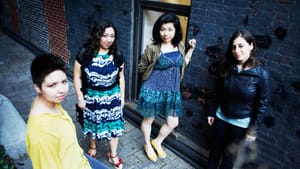Stay in the Loop
BSR publishes on a weekly schedule, with an email newsletter every Wednesday and Thursday morning. There’s no paywall, and subscribing is always free.
In C in the round
Terry Riley's 'In C' at the Kimmel Center

Now over half a century old, the musical movement known as minimalism still provokes polarized responses. For some, it single-handedly saved classical music from its self-imposed obsolescence; for others, it sold out the art to the vacuity of popular culture at its worst. But whatever one’s opinion of it, minimalism’s influence is beyond question. Based on a constant, unremitting rhythmic pulse, gradually unfolding forms, and lots and lots of repetition, minimalism provided a broad framework within which composers could stake out distinctive personal styles. It was arguably the last great musical movement or “-ism” of the 20th century.
One of the foundational works of minimalism, In C, by American composer Terry Riley, recently marked the 50th anniversary of its premiere. On December 11, eighth blackbird, the Aizuri Quartet, and members of the Curtis Institute's contemporary music ensemble Curtis 20/21 joined forces for a performance of In C at the Kimmel Center's SEI Innovation Studio. (Full disclosure: I teach 20th-century music at Curtis, and a few of my students were among the performers.)
Open score
Like many early minimalist pieces, In C is notated as an “open score”: It provides performers with specific musical material to play, but the precise nature of a given performance varies considerably according to the performers' choices and the vibe of the ensemble. (A quick YouTube search yields a plethora of performances, each radically distinct and yet each indisputably In C.) The number of players, and their instruments, is left unspecified in the score. Each performer plays from the same score, which contains 53 mostly short, mostly simple melodic figures in the key of C major — hence the title. Performers are directed to repeat each figure ad libitum, creating a teeming, twittering chaos of superimposed melodies.
This version featured a mixed ensemble of percussion (tuned and untuned), strings, piano, and woodwinds, plus a few nonclassical instruments like the electric guitar. The stationary instruments were placed in a cluster in the center of the room, while mobile performers meandered about the space, forming various ad-hoc micro-ensembles that locked in on particular melodic cells.
On the whole, the performance was considerably more polished and “classical” than most versions of the piece that I've heard. (The 1964 premiere was performed by a decidedly mixed ensemble of classical, rock, and jazz musicians, and the piece's relative simplicity opens the door to performers of various backgrounds and training.) Purists might decry the lack of rough edges, but the performance brilliantly channeled the piece’s wild, improvisatory energy. The best moments of In C happen when the whole thing seems on the verge of falling apart, its delicate order dissipated as if by centrifugal force — and when, at the last moment, the catastrophe is averted by the magical rematerialization of the pulse.
Groovy time travel
Finally, a word about the presentation. To celebrate the 50th anniversary of the premiere of In C, the SEI Innovation Studio was transformed into a 1960s lounge atmosphere, complete with cocktails, op art projected on the walls, and period-appropriate background music from Motown and the British Invasion. This ambience combined with the intermingling of performers and audience to create a relaxed and sociable mood more typical of a rock or jazz show than a classical concert.  It was refreshing to see “classical music” (if indeed the name fits) performed with such a spirit of inclusiveness and fun.
It was refreshing to see “classical music” (if indeed the name fits) performed with such a spirit of inclusiveness and fun.
Sometimes overlooked amid the belabored discussions of classical music’s survival (afterlife? reincarnation?) is the incontrovertible fact that the concert as we know it will have to change. There is no panacea here, no one-size-fits-all solution. In C happily lends itself to the informal “drinks and dressing-down” approach, but other pieces would suffer from this format. New forms of presentation will have to be tailored to the character of the music.
Above right: photo of eighth blackbird by Luke Ratray, used with permission.
What, When, Where
Curtis Institute of Music Residency Recital: eighth blackbird, Aizuri Quartet, and the Curtis 20/21 Ensemble. In C by Terry Riley. December 11, 2014 at 6pm and 9pm. SEI Innovation Studio, Kimmel Center, Broad and Spruce Streets, Philadelphia. www.curtis.edu
Sign up for our newsletter
All of the week's new articles, all in one place. Sign up for the free weekly BSR newsletters, and don't miss a conversation.
